Before traveling to India, I was wondering about how to go to the bathroom. I heard there would be no toilet paper and I would have to squat, which made me wonder, Do Indians use toilet paper?
Most Indians don’t use toilet paper and prefer to use water. Traditional toilets (also called squat toilets) will have a small hose with sprayer or a faucet and mug. Although tourist resorts and restaurants do offer toilet paper and have Western-style toilets.
In a poll I conducted with more than 1000 Indian travelers, 63.7% said they NEVER use toilet paper. 25.17% said they SOMETIMES use toilet paper. Only 3.48% said they ALWAYS use it.
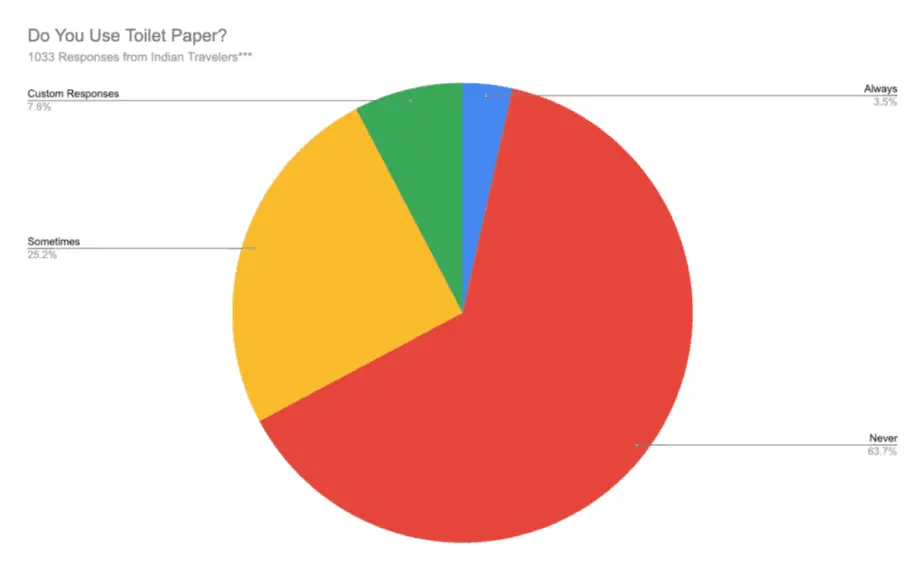
Indian toilets typically have a water spray hose (sometimes called a “bum gun”) near the toilet or there is a faucet with a small bucket (called a “lota”). These are common across Asia in places like Nepal, Bhutan, Sri Lanka, Pakistan and Bangladesh as well.
Indonesia, Thailand, the Philippines and Malaysia also prefer using water.
On the other hand, Americans use an average of 20,292 sheets of toilet paper and spend $39.99 a year on their toilet paper of choice. The toilet paper market is big too. In 2020, it had $13,235 million in revenue, which is projected to grow by 2%. China’s market for toilet paper is $16,582m in 2020.

Most Indians think using toilet paper is gross. And most Americans think using just water and your fingers is disgusting. Why is there such a difference?
If you’re traveling to India and curious about the customs of this wonderful country, then read on to understand how Indians use the toilet and how you can do your “business” here as well.
Read More: If you’re traveling to India, check out my free budget worksheet to figure out how much it will cost.
How Do Indians Use the Toilet?
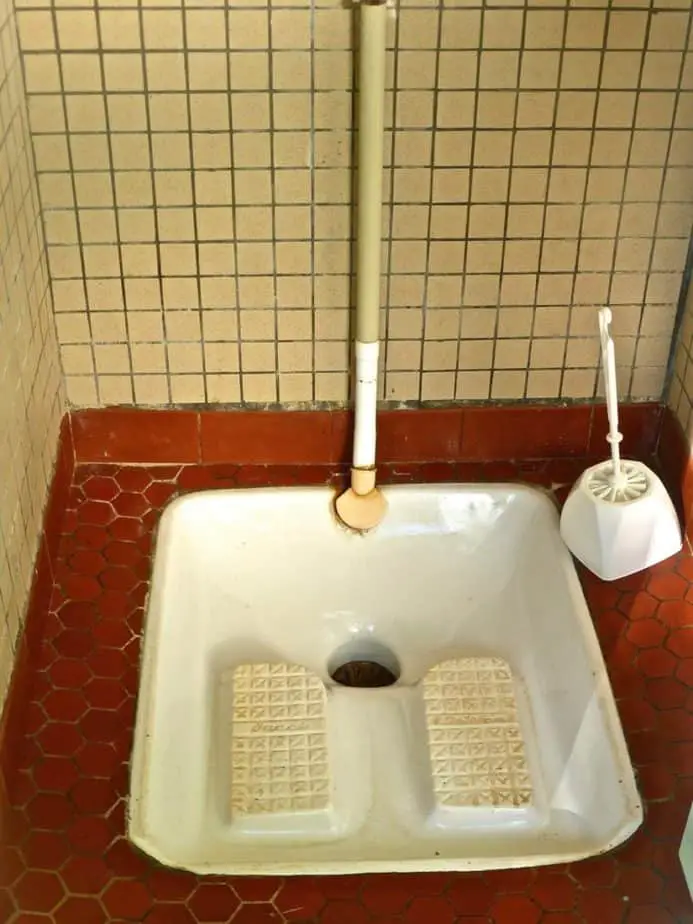
The traditional way of using the toilet in India is to use a squat toilet with a water hose or faucet and a small mug of water or “lota.”
The squat toilet might seem scary-looking but it has some physical benefits. Squatting down is the most ergonomic way to use the bathroom. It can help prevent “fecal stagnation,” which has been found to cause colon cancer, inflammatory bowel disease, and appendicitis.
The squatting body position helps you defecate faster and easier, which could also mean less chance of hemorrhoids.
You also don’t touch a toilet seat to your skin, which might reduce the spread of some bacteria.

However, these toilets are rarer these days. You might see them at local roadside restaurants though. If you’re traveling in India and staying in hotels, then you’re going to see mostly Western toilets. I’ve been in India for over a year and a half, and I have only used a squat toilet a handful of times.
Most hotels have toilet paper as well. However, there is always a sign to NOT put it in the toilet. The plumbing system in India will easily back up if you put the paper in the toilet. Instead, there’s a small trash can where you can put the paper.
Read more: Culture Shock in India: A Big List Of Things To Be Aware Of
Why Don’t Most Indians Use Toilet Paper?

The main reason most Indians don’t use toilet paper is because water is more accessible. Picture living in a village 25 years ago, there probably wasn’t much Charmin around.
When I asked Indians why they don’t use toilet paper, I found that there were a few main reasons:
- Water is more accessible
- Water is more hygienic
- Water is purer
Water is More Accessible Than Toilet Paper
The World Health Organization found that 2 billion people worldwide still do not have toilets or latrines. 673 million people still use the bathroom in the open air, such as in gutters or near bodies of water.
According to the BBC, nearly half of India’s population does not have a toilet at home.
Many people still regularly go to the bathroom outside. I live on the outskirts of a small city here in India and I can often see people squatting and using the bathroom out my window.

Toilet Paper Fact: T’sai Lun is little-known but scholars consider him the first guy to invent toilet paper. He made paper from mashed up rags, hemp, fishing nets, and mulberry in China.
People have always wiped with what they had on-hand. Before toilet paper came to the West, people used fruit peels, moss, rocks, sticks, apple husks, corn cobs, rags, leaves, and the local water supply. Rich people would use softer fabrics like hemp, lace, or wool.
Later in the USA, people would use the Sears Catalog or the Farmer’s Almanac, which came with a hole already in the book for easy hanging in the bathroom. You could read and wipe all at once.
It wasn’t until the 1800s that toilet paper was invented in the USA and marketed to the masses. AND it actually first came from China many centuries ago.

In the Tang Dynasty in China, toilet paper was recorded as being used in the year 851. It wasn’t common though. 500 years later, in the Ming Dynasty toilet paper was made of soft cloth and perfumed. It was only used by the Emperors and their family.
Using toilet paper was considered unclean even then. In the 9th century, a visitor to China from the Middle East was quoted as saying that the Chinese ‘are not careful about cleanliness, and they do not wash themselves with water when they have done their necessities; but they only wipe themselves with paper.’
At this time in India, you can imagine Indians living in a village couldn’t go to the local Wal-mart to buy a 24 pack of Charmin, so using water and other items that were close at hand were common.
Then as water was available in homes and businesses, it was easy and cheap to add a water spray hose next to the toilet. That practice has continued to today in India and many countries.
Water is More Hygienic
Indians don’t consider something clean unless it has been washed with water. And they’re right.
Imagine for a second that you spilled some pudding on your floor. Would you wipe it up with paper alone? Or would you use water?
Do you shower with a dry towel?
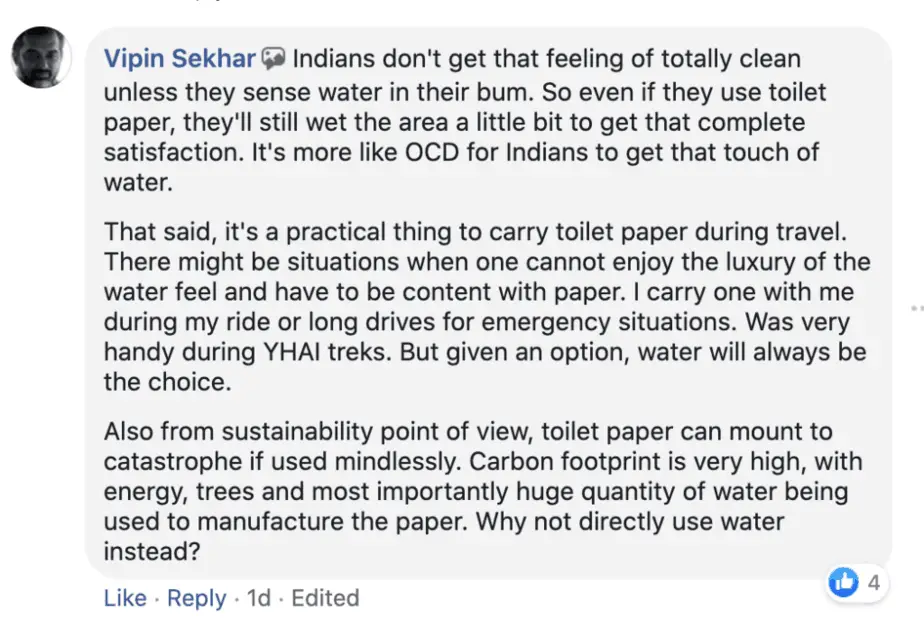
Water is called the universal solvent for a reason. Water dissolves more substances than any other liquid on Earth.
Toilet Paper Fact: In public bathrooms in Rome, you would use a tersorium to wipe. This ancient “toilet paper” was a sponge on a stick with a bucket of vinegar or salt to dip it in after you were finished.
Dr. Allen Kamrava, colorectal and general surgeon from California says that people who use water to wash “are much less likely to have issues with rashes and discomfort and irritation” in CNA Lifestyle.
This is one reason the bidet was first recorded as an invention in Italy in 1726. Many people think French furniture designers invented it though. However, America gets a lot of traditions from the UK and in early Britain the bidet was often found in brothels, so it didn’t really catch on as people migrated to the USA.

In the 1960s the bidet was reintroduced to the USA and it never took off.
But for the sake of cleanliness, maybe it should have. The chief medical officer of The Urology Group in America, Dr. Phillip Buffington also stated, “Think about using dry toilet paper. You’re leaving a residue of stool and bacteria, whereas if you’re using a bidet, you’re washing that away.”
Water is Purer
In the Fair Observer, Praveen Kishore discusses the worldview of Indians and Southeast Asians and how being “pure” has an impact on their actions.
In Hinduism, purity is very important. Shoes are not allowed into temples, because they’re unclean. In the city where I live there was a long comment on Facebook about people not carrying shoes into the ashram, even in their backpacks in plastic bags.
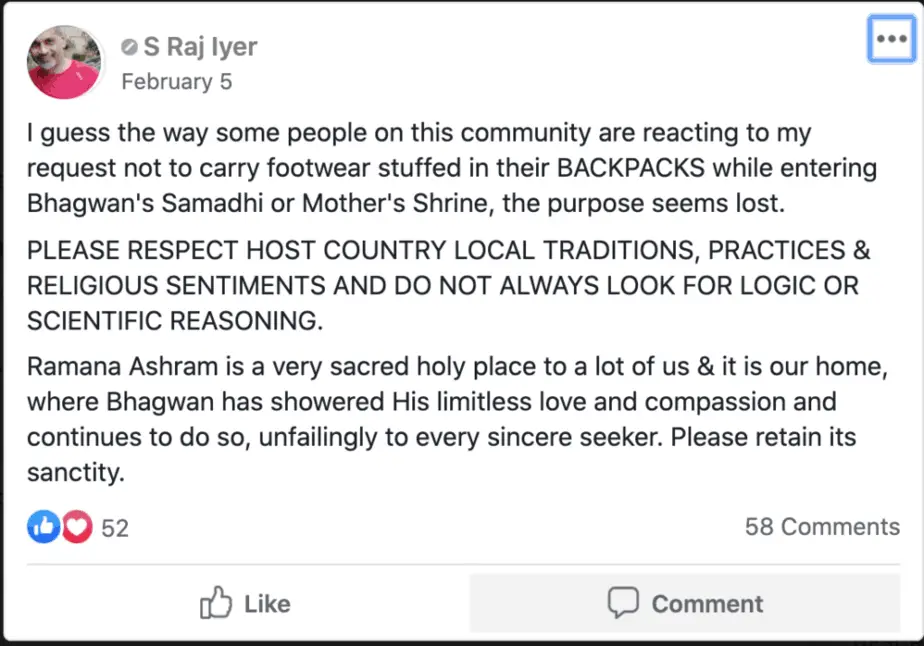
Now from a Western perspective this seems odd, since the shoes are in a backpack there isn’t a way the could make a place any less clean.

Yet as Praveen Kishore goes on to explain the idea of cleanliness or purity goes beyond just physical cleanliness, but it also refers to your spirit and soul.
Washing with water is also a way to purifying your body and soul, in the same way that showering is thought to purify your soul and spirit.
Culturally, the Indian psyche does not make a clear distinction between cleaning, which is hygienic and clinical in its nature, and purifying, which is ritual and religious in its implications.
Praveen Kishore, How Do Indians Clean Their Bottoms?
Of course, there is the problem of cleaning your butt with your fingers and making them “impure.” This is why people wash their hands with soap AND why the left hand is thought of impure. This is also why people don’t shake hands with their left hand or eat with it.
Read more: A Huge List of Dos & Don’ts While Traveling India
How I Learned To Use The Bum Gun, Instead of Toilet Paper
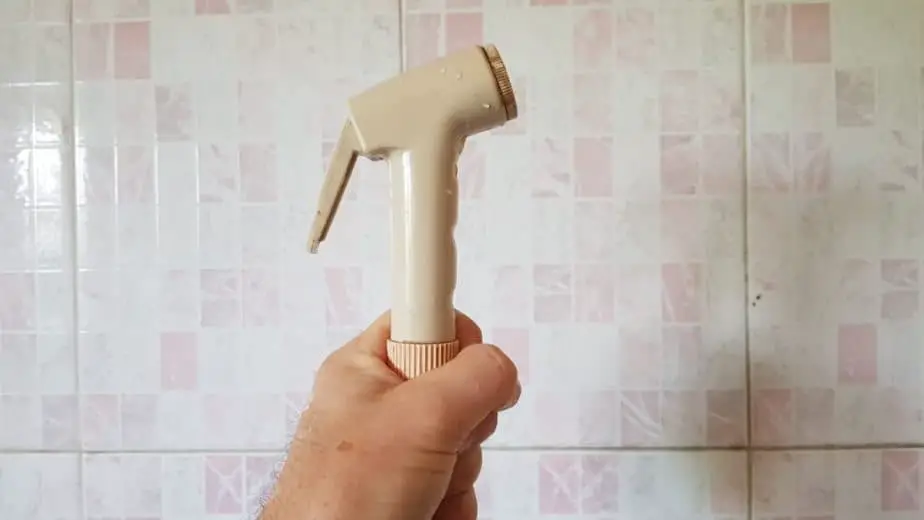
Using water to “wipe” in Indian took some getting used to. At first, I didn’t feel like I was getting fully cleaned and I definitely didn’t like walking out of the bathroom with a wet bum.
But I did like how it felt to wash up after going to the bathroom. Plus, it tickles 😉

I asked female friends too and they said they feel cleaner using water. My girlfriend likes using water, but always uses toilet paper to dry afterwards because she doesn’t like the wet feeling.
Some Indians felt the same way, Samridhi Arora was quoted in the Deccan Chronicle when asked about switching to toilet paper. “No need to ‘Switch’… all we need to do is ‘Add’. The best solution: Now, just like we bath and then use a towel to pat ourselves dry…use the Spray to clean yourself thoroughly and then use a tissue to pat yourself dry.”
Read more: The Best Times To Visit India’s Most Popular Destinations
FAQs
Why Don’t They Use Toilet Paper in India?
Toilet paper didn’t come to India until 1935 officially when it was introduced in newspaper, according to the Economic Times. So it wasn’t available for most people.
Even today, the average income of Indians is 16,000 INR, according to Money Mint, so most people couldn’t afford it.
However, in Hinduism water is also seen as a way to purify something and without cleaning with water something is seen as unclean.
Tourists will easily be able to find toilet paper in their hotels and restaurants though. I have only seen a squat toilet a few times and I’ve been in India for years.
How Do They Wipe Their Bum in India?
95% of Indians use water and their left hand to wipe. Some use toilet paper to dry off afterwards. Only a small minority use toilet paper exclusively.
Most hotels and restaurants catering to tourists will have a Western-style toilet with a spray hose and toilet paper.
Which Countries Do Not Use Toilet Paper?
India is not the only country that doesn’t use toilet paper. Many Asian countries do not use toilet paper as well such as China, Singapore, Thailand, Taiwan and Korea.
In Europe, using a bidet is common. It makes a lot of sense to since using water to clean is more hygienic.
Japan uses some fancy bidets as well.
How Do Indian Use Toilets In the US?
There are many Indians living in the USA and many still use water to clean in the bathroom. However, toilet paper is more commonly accepted as well.

